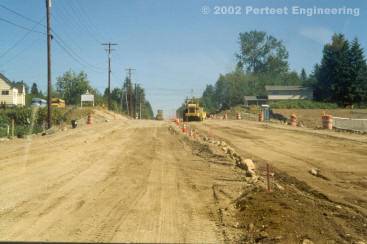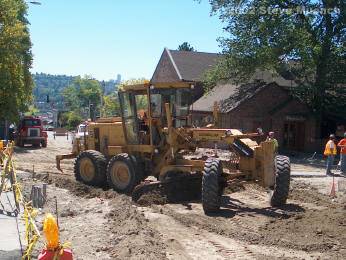Subgrade
The “subgrade” is the in situ material upon which the pavement structure is placed. Although there is a tendency to look at pavement performance in terms of pavement structure and mix design alone, the subgrade can often be the overriding factor in pavement performance.

Figure 1: Subgrade Preparation on SR 528

Figure 2: Subgrade Preparation on University Avenue in Seattle
Subgrade Performance
A subgrade’s performance generally depends on two interrelated characteristics:
- Load bearing capacity. The subgrade must be able to support loads transmitted from the pavement structure. This load bearing capacity is often affected by degree of compaction, moisture content, and soil type. A subgrade that can support a high amount of loading without excessive deformation is considered good.
- Volume changes. Most soils undergo some amount of volume change when exposed to excessive moisture or freezing conditions. Some clay soils shrink and swell depending upon their moisture content, while soils with excessive fines may be susceptible to frost heave in freezing areas (normally a concern east of the Cascade mountains).
WAPA Pavement Note on Expansive Soils
Expansive soils are ones that swell in volume when subjected to moisture. These swelling soils typically contain clay minerals that attract and absorb water. When water is introduced to expansive clays, the water molecules are pulled into gaps between the clay plates. As more water is absorbed, the plates are forced further apart, leading to an increase in soil pore pressure (Handy 1995). If this increased pressure exceeds surcharge pressure (including the weight of the pavement) the soil will expand in volume to a point where these pressures are once again in balance.
Poor subgrade should be avoided if possible, but when it is necessary to build over weak soils there are several methods used to improved subgrade performance:
- Removal and replacement (over-excavation). Poor subgrade soil can simply be removed and replaced with higher quality fill. Although this is simple in concept, it can be expensive.
- Additional base layers. Marginally poor subgrade soils may be made acceptable by using additional base layers. These layers spread pavement loads over a larger subgrade area. This option is rather perilous; when designing pavements for poor subgrades the temptation may be to just design a thicker section with more base material because the thicker section will satisfy most design equations. However, these equations are at least in part empirical and were usually not intended to be used in extreme cases. In short, a thick pavement structure over a poor subgrade may not make a good pavement.
- Stabilization with a cementitious or asphaltic binder. The addition of an appropriate binder (such as lime, portland cement or emulsified asphalt) can increase subgrade stiffness and/or reduce swelling tendencies.
Subgrade Physical Properties
Subgrade materials are typically characterized by (1) their resistance to deformation under load, in other words, their stiffness or (2) their bearing capacity, in other words, their strength. In general, the more resistant to deformation a subgrade is, the more load it can support before reaching a critical deformation value. Although there are other factors involved when evaluating subgrade materials (such as swell in the case of certain clays), stiffness is the most common characterization. There are three basic subgrade stiffness/strength characterizations commonly used in the U.S.:
- California bearing ratio (CBR). A simple test that compares the bearing capacity of a material with that of a well-graded crushed stone (thus, a high quality crushed stone material should have a CBR @ 100%). CBR is basically a measure of strength. It is primarily intended for, but not limited to, evaluating the strength of cohesive materials having maximum particle sizes less than 0.75 inches (AASHTO, 2000). It was developed by the California Division of Highways around 1930 and was subsequently adopted by numerous states, counties, U.S. federal agencies and internationally. Most agency and commercial geotechnical laboratories in the U.S. are equipped to perform CBR tests.
- Resistance value (R-Value). A test that expresses a material’s resistance to deformation as a function of the ratio of transmitted lateral pressure to applied vertical pressure. It is essentially a modified triaxial compression test. Materials tested are assigned an R-value. The testing apparatus used in the R-value test is called a stabilometer and is identical to the one used in Hveem HMA mix design. The R-Value is basically a measure of stiffness.
- Resilient modulus (MR). A test used to estimate elastic modulus (a material’s stress-strain relationship). The resilient modulus test applies a repeated axial cyclic stress of fixed magnitude, load duration and cyclic duration to a cylindrical test specimen. While the specimen is subjected to this dynamic cyclic stress, it is also subjected to a static confining stress provided by a triaxial pressure chamber. It is essentially a cyclic version of a triaxial compression test; the cyclic load application is thought to more accurately simulate actual traffic loading. Resilient modulus is basically a measure of stiffness.
Table 1: Typical CBR and Modulus of Elasticity Values for Various Materials
| Material (USC given where appropriate) |
CBR | Elastic Modulus (psi) |
| Diamond | – | 170,000,000 |
| Steel | – | 30,000,000 |
| Aluminum | – | 10,000,000 |
| Wood | – | 1 – 2,000,000 |
| Crushed Stone (GW, GP, GM) |
20 – 100 | 20,000 – 40,000 |
| Sandy Soils (SW, SP, SM, SC) |
5 – 40 | 7,000 – 30,000 |
| Silty Soils (ML, MH) |
3 – 15 | 5,000 – 20,000 |
| Clay Soils (CL, CH) |
3 – 10 | 5,000 – 15,000 |
| Organic Soils (OH, OL, PT) |
1 – 5 | < 5,000 |
WAPA Pavement Note on Subgrade Stiffness/Strength Tests
All three types of subgrade stiffness/strength tests are used in Washington State to some degree. WSDOT uses the resilient modulus when possible, while many geotechnical firms typically use CBR. Although not common any more, WSDOT still has an R-Value procedure (T 611). It is possible to convert one value to another but these conversions are based on empirically derived equations and may not be appropriate for the specific conditions being considered. Use the below conversion equations with extreme caution. For instance, in WSDOT Test Method 611 “design R-Values” are determined at an exudation pressure of 400 psi, while AASHTO T 190 allows the use of a 300 psi exudation pressure. Thus, WSDOT R-Values may differ from AASHTO R-Values.
A widely used empirical relationship developed by Heukelom and Klomp (1962) and used in the 1993 AASHTO Guide is:
MR = (1500) (CBR)
This equation is restricted to fine grained materials with soaked CBR values of 10 or less. Like all such correlations, it should be used with caution.
Similarly, the 1993 AASHTO Guide offers the following correlation equation between R-value and elastic modulus for fine-grained soils with R-values less than or equal to 20.
MR = 1,000 + (555)(R-value)
A WSDOT developed relationship between the R-value and resilient modulus is shown below.
MR = 720.5 (e0.0521(R-value)-1)
Design Factors



